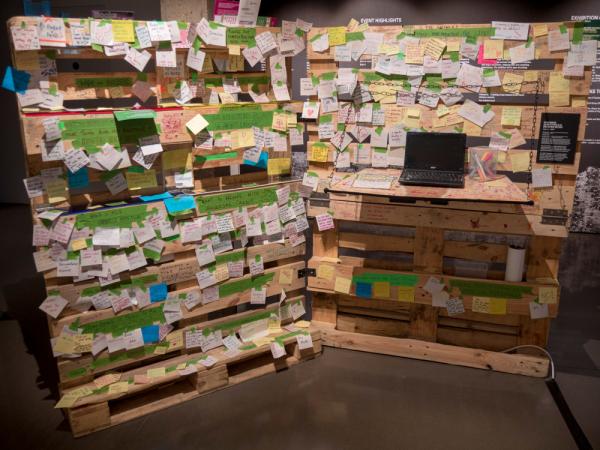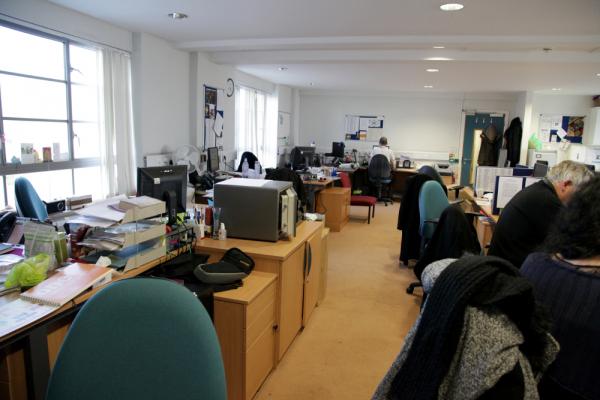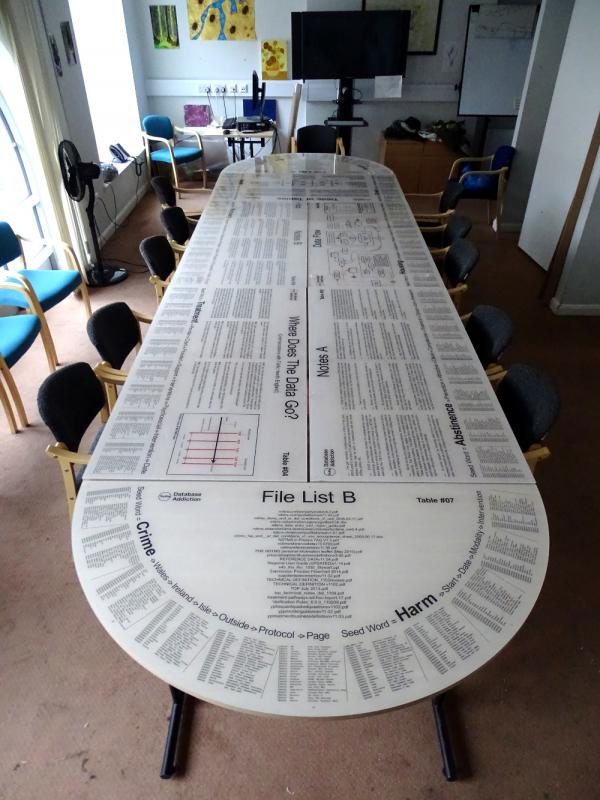
Database Addiction 2015-19

Being an addict is frustratingly hard work, finding substances, food, shelter, care, treatment are complicated formations that require knowledge situated in the actions and reactions of being addicted yet this knowledge never enters into the machinery of governance that purportedly cares for drug users in the UK. This situated knowledge has much to tell us about forms of reticulated discipline that governs addicts and workers in the UK care system.
Database Addiction is a collaboration instigated by the YoHa, working with Dr Luke Mitcheson, Jean Demars, Samantha Penn, and others and produced by Anila Ladwa. The project has been supported by a Critical Friends Group convened by Dr Alison Rooke and generously funded by the Wellcome Trust.

In 2015 a first enquiry took place at Lorraine Hewitt House, an addictions clinic in the heart of Brixton, London. It is staffed by a busy and engaged, team of dedicated drug workers, clinical psychologists, social workers, psychiatrists, administrators and reception staff. The clinic is itself a collapsed set services, administrative machines and architectures awkwardly housed together through cuts in funding, monetisation and policy changes. Along with such cuts comes the conflation of machinery, furniture and forms of administration. Many people have to repeat the same information in different systems that have no protocol to share resources.
All the work at the addictions support centre is interrelated to collections of information that in turn evidence decisions and activities and result in quantifiable structures that reciprocally create other individual actions.
YoHa took an ecological and aesthetic approach to working with the UK’s National Health Service to investigate how databases produce an abstraction of the clinical modalities resulting in the table of tables. Database Addiction explored the methods by which the materiality of the care-centres work can be managed and governed at multiple scales from within computation and how such processes transform work based cultures and the lives of so called addicts.
Database Addiction had several objectives
To explore how databases mediate relationships within health care services.
With particular emphasis on exploring the inter-relationships to databases between: front-line staff and management and management and the commissioners, between care providers and service users.
To explore what role art can play in staff development by enabling critical readings of their techno-social environment and offering creative ways to understand how database affect the delivery of services.
To explore the interrelationships between mental health and the forms of digital rationality with which we manage or treat it .
YoHa's first enquiry took place at Lorraine Hewitt House, an addictions clinic in the heart of Brixton, London. It is staffed by a busy and engaged, team of dedicated drug workers, clinical psychologists, social workers, psychiatrists, administrators and reception staff, with a heavy workload. The clinic is itself a collapsed set services, administrative machines and architectures awkwardly housed together through cuts in funding and policy changes. Along with such cuts comes the conflation of machinery, furniture and forms of administration. Many people have to repeat the same information in different systems that have no protocol to share resources.
All the work at the addictions support centre is interrelated to collections of information that in turn evidence decisions and activities and result in quantifiable structures that reciprocally create other individual actions.
There are two key formation that produce the keystones of the project.
Art as Enquiry – which can be thought of as a method that makes the space between theory and practice ambiguous. We can loosely think of it as an aesthetics of engagement with practice or to put it another way, the multiple scales of making, or engaging with the process of art type projects. In Database Addiction, asking people questions, changing the space, being present, paying attention, all affect changes on different scales.
You can imagine this as a yearning for an aesthetics that fall outside of our current ability to represent them.
The artist makes things, propositions attempting to explain the phenomena caught in the gaze of the project. Not by a reduction of phenomena to literature or a system of logics, but instead this can be thought of as knowledge incorporated into a thing that the artist creates or points to, through revealing a gaze. (This is not the gaze of the audience of art but can be thought of as being nearer to the gaze of clinician trying to formulate a diagnosis.)
Added to this notion of Art as Enquiry is a simple reading of discipline in computation derived with Matt Fuller - when we were thinking about Abstract Urbanism
Using and programming computers implies the interrelation of different forms of logic, both at the level of programming the machine in order to perform calculations, and at that of regulating the conduct of users in manipulating mice and menu systems in order to produce desired results. One way to think about how the mass adoption of these forms of logic effects the clinic is in the mode of what Michel Foucault described as discipline, as it entails analysing and breaking down a phenomenon through modelling it to produce a kind of remote control. Computation disciplines the way a phenomenon is approached and analysed, so that when it becomes visible again from within the computer, it makes the phenomenon materially available for comparison and modification. As users participate in the flows of power created by comparing information they become normalised to its process and entangled in the inter-relation of logics at different scales.

The logics represented on this table interrelate through disciplining the organisation and forcing compliance with various databases through such mechanisms as the Treatment Outcomes Profile (TOP) which purportedly ‘measures change and progress in key areas of the lives of people being treated in your drug and alcohol services.’ This form of compliance affects overall funding, policing staff efficiency and job security.
The enterprise of the clinic sits at the nexus of several databases: the National Drug Treatment Monitoring System (NDTMS), Electronic Patient Journey System (ePJS) which is used more generally by the national service along with other Spine databases.
Data collection occurs at the end of each month with the (Drug and Alcohol Monitoring System (DAMS) system which opens for CSV submissions in the middle of the month. All staff must complete TOPS forms for all drug users by this date. A traffic light system is incorporated into the software to create compliance. Data must be submitted to National Data Set (NDTMS Central)
This is an 11 month cycle August to June. July is omitted in the production of Frozen Dataset which is for annual statistics in which the attention of the machine is given over to another scale. The individual subject data is attributable to a drug user by (initial, DOB, gender, only half the postcode) We found that DAMS uses both Role Based Permissions (people with certain roles/permissions can view things others cannot) to construct veiws of the monitoring system. It also uses System Security Policies protocols in which if you have entries in an area where by you have a 1 in 5 chance of people being identified through the data then that data must be suppressed.
There is some provision made for private actors getting access to the DAMS for various research interests including revising the workings of the database.

In the first phase of the project we only worked with staff and drug users representatives. The project tried to experiment with understanding how technical forms help construct it's subject at multiple scales. It's important to state that it is no longer credible for artists wishing to pursue a critical enquiry to work only with marginal groups without working with the structures that create the boundaries from which the margins are measured.
The project itself close read the structure of the the UK’s National Drug Treatment Monitoring Service, a series of business plans (conceptual views) for the database that when unlocked articulate addiction from an ideological, technical, political, bureaucratic or governmental viewpoint that is used amongst other things for monetising addiction services. UK addicts are data rich subjects – this wealth of information can be explained by politicians need to justify spending on addicts as a group ironically described as undeserving sick by the clinical psychologists. Keeping the addicted on a perpetual treadmill of monitoring, with substitute opiates, is far cheaper than the dealing with the outfall of criminal activity needed to maintain a habit on the street.
This talk will explore the materiality of database algorithms, from urine and blood samples to entities and relations to the architecture of clinical, administrative meetings. This formation can be seen as pointers to a fluid formation of power that is not only a strategy in action for government but holds itself open as an emergent ambiguous diagram, a sketch of relations and a technical machine for reticulate discipline. A theatre for the performance of power with a capability to insight, provoke, to compare and combine what ideology can articulate about addiction and at the same time is coextensive with creating new knowledge. A kind of abstract R&D that points to the kinds of control governance might find ideal but has not mastered yet.
In the interests of opening up this form of practice in the context of reticulation – instead of trying to create some grand narrative to the project YoHa would like to explore with you the methods of enquiry, the questioning of assumptions, the thought experiments undertaken, the formal properties of the databases that we could question.
YoHa and it's collaborators wanted to look at databases acting in a addiction clinic environment, to ask questions of the participants, listen to them and understand their working relationship with databases. YoHa would negotiate access to the structures and formations of records, and chart the flows of permission needed to access them. This questioning and listening, and the following of permissions and structures, allows all of the participants – willingly or unwillingly – to reflect on those structures through asking questions about how the work based culture is constructed in collaboration with databases. YoHa working with the material would then propose an artistic diagram of the flows of power and governance that we derived from mapping the database and its constructs. Making such structures visible, and figuring them even if they are incorrect or eccentric, allows the structures to become strange again. It thus allows them to be debated, evolved and contested outside the normal conditions (or discourses ) of a clinical environment.
The tables produced for the clinic are an attempt to think through the structural coupling of databases and the intention of the clinic. Databases, are more often than not, regarded as a technical solution with scant regard to their culturalisation, sociality, or the way in which the knowledge and the power, or the architectural relations, are then altered by them.
Most people work with the ePJS which has background processes and sorting algorithms that extract information into other systems such as the NDTMS whose enterprise is summarised as: 'the process of information from and for those involved in and around the governance of drug treatment.'
The databases investigated are a form of list architecture that produce an abstraction of the support centre modalities. They afford methods by which the materiality of the support centres work can be managed and governed at multiple scales with computation. This process of abstraction while allowing distance and overview from the gritty work of dealing with addiction is also by necessity, always incomplete and structurally flawed, as the representation of the experience of the support centre.
Summary:
The structure of the the NDTMS unlocks what is articulated about addiction from an ideological, technical, political, bureaucratic or governmental viewpoint, which is used amongst other things for monetising addiction services. The NDTMS can be seen as pointers to a fluid formation of power that is a strategy in action. While this formulation can be useful in understanding this strategy as a navigable fluid architecture it tells us very little about how individuals manipulate or resist the modalities it creates.
“My alcohol dependant clients have a high risk of death or of otherwise ‘failing’ according to the database so putting their info in would affect metrics negatively.”
The staff of clinic spoke about how they would work with people who did not have a presence within the dataset. As the NTDMS only rewards the clinic if people are free from from addiction for a period of six months, no economic value can be derived from a group of street drinkers . The staff who wish to work with this group make up, or bend the entries into the system with full knowledge of management. The tension between good practice in healthcare and the governance afforded by the database expresses itself in the ambiguity of record keeping.
Database Addiction Table of Tables Information:
The ‘notes’ are derived from conversations with staff at the addictions support centre: drug workers, clinical psychologists, social workers, managers and administrators, including reception staff.
Further notes under header ‘Where Does The Data Go?’ are from email correspondence with representatives of Public Health England about the inner workings of the DAMS and NDTMS databases in the spring of 2015.
The word lists around the edge of the tables is derived from pdf text files publicly available online (see lists on the semicircle tables), collected throughout our research. The files were analysed to find the collocations of words in the documents to create an aesthetic discourse analysis, to explore how our language is informed by the machines that process it. Each word in the list is related to both the one's below and those that are adjacent to it.
The Data Flow Chart: Describe
“These compliance targets need to be logged and are automatically part of the framework - “mandatory field completions” - which the clinic uses to log people’s data”
 bnr#87 =>
bnr#87 =>